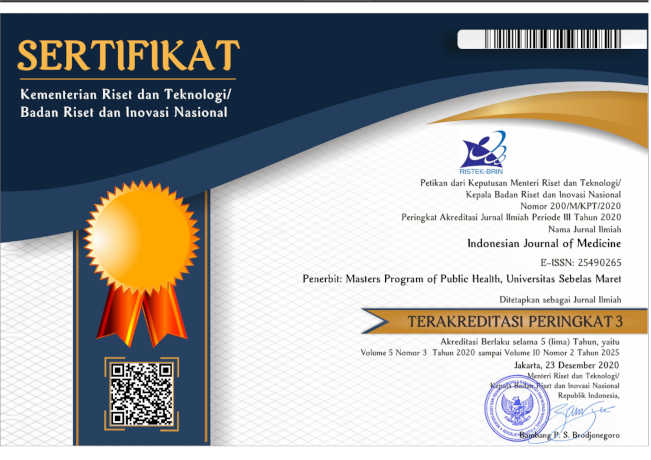Vascular Endothelial Growth Factor-C Expression in Servical Squamous Cell Carcinoma of Patients with Neoadjuvant Chemotherapy
DOI:
https://doi.org/10.26911/theijmed.2019.4.1.154Abstract
Background: Uterine cervical carcinoma is the most gynecological malignancy in women worldwide. The most common type of cervical carcinoma histology is squamous cell carcinoma and has a better prognosis than adenocarcinoma. Neoadjuvant chemotherapy is the management of early-stage cervical carcinoma before radical hysterectomy is performed. In addition to clinical-pathological factors, biomolecular markers are now being developed and used as parameters for evaluating chemotherapy responses. Vascular Endothelial Growth Factor-C is a VEGF derivative that plays a role in the process of vasculogenesis, limphangiogenesis, and the formation of new lymphatic channels which play an important role in metastasis. This study aimed to examine the effect of Paxus-Carboplatin chemotherapy in decreasing VEGF-C in squamous cell cervical carcinoma tissue.
Subjects and Method: This was a quasi experiment study conducted at Department of Obstetrics and Gynecology and Pathology Anatomy Laboratory of Dr. Moewardi Hospital/ Faculty of Medicine, Universitas Sebelas Maret. 25 tissue samples of squamous cell stage IB2-IIA2 cervical carcinoma immunohistochemistry VEGF-C expression was carried out before and after Paxus-Carboplatin chemotherapy was given. The data were analyzed by Wilcoxon test.
Results: VEGF-C expression in squamous cell cervical carcinoma tissue after chemotherapy was lower (mean = 4.20) than before chemotherapy (mean = 6.16) and it was statistically significant (p<0.001).
Conclusion: Neoadjuvant chemotherapy decreases VEGF-C in squamous cell cervical carcinoma tissue.
Correspondence: Uswatun Khasanah Kartikasari. Department of Obstetrics and Gynecology, Faculty of Medicine, Universitas Sebelas Maret/ Dr. Moewardi Hospital, Surakarta. Mobile: 081391444425. Email: uswatunkk@gmail.com
Indonesian Journal of Medicine (2019), 4(1): 40-45
https://doi.org/10.26911/theijmed.2019.04.01.07
References
Agustiyansah P (2014). VEGF-C serum level as predictor lymph node metastasis in advanced stage cervical cancer. Indonesian Journal of Cancer. 8(3). Google Scholar
Aziz MF (2009). Gynecological cancer in Indonesia. Journal of Gynecologic Oncology. 20(1): 8–10. doi: 10.3802/jgo.2009.20.1.8 Crossref Google Scholar
Chang YW, Yu YH, Chen JC, Su JL, Hong CC (2012). The Role of the VEGF-C/VEGFRs Axis in Tumor Progression and Therapy. International Journal of Molecular Sciences. 14(1): 88–107. doi: 10.3390/ijms14010088 Crossref PubMed Google Scholar
Franc M, Kachel-Flis A, Michalski B, Fila-Daniłow A, Mazurek U, Michalski M, Michalska A, Kuczerawy I, Skrzypulec Plinta V (2015). Lymphangiogenesis In cervical cancer evaluated by expression of the VEGF-C gene in clinical stage IB-IIIB. Przeglad Menopauzalny. 14(2): 112–7. doi: 10.5114/pm.2015.49397 Crossref PubMed Google Scholar
International Agency for Research on Cancer (2012). Globocan 2012 Cancer Fact Sheet’, International Agency for Research on Cancer, pp. 1–6. Website
Lindstr A (2010). Prognostic factors for squamous cell cervical cancer, Oncology. Google Scholar
Mandic A, Knezevic SU, Ivkovic TK (2014), Tissue expression of VEGF in cervical intraepithelial neoplasia and cervical cancer.Journal of B.U.ON. 19(4): 958–64. doi: no doi Crossref PubMed Google Scholar
Ministry of Health (2013). Panduan Penatalaksanaan Kanker Serviks. Komite Penanggulangan Kanker Nasional. . Google Scholar
Morfoisse F, Renaud E, Hantelys F, Prats AC, Garmy-Susini B (2014). Role of hypoxia and vascular endothelial growth factors in lymphangiogenesis. Molecular and Cellular Oncology. 1(1): 1–8. doi: 10.4161/mco.29907 Crossref PubMed Google Scholar
Nakamaura K, Aoki D, Umene K, Banno K, Yanokura M, Iida M, Kisu I, Tanaka K, Nogami Y, Adachi M, Iwata T, Masuda K (2014). Candidate bio-markers for cervical cancer treatment: Potential for clinical practice (Review). Molecular and Clinical Oncology. 2(5): 647–55. doi: no doi Crossref Google Scholar
Osman M (2014).The role of neoadjuvant chemotherapy in management of locally advanced cancer cervix: A systemic review. Oncology Reviews. 8(2). doi: 10.4081/oncol.2014.250 Crossref PubMed Google Scholar
Powell NG, Hibbitts SJ, Boyde AM, Newcombe RG, Tristram AJ, Fiander AN (2011). The risk of cervical cancer associated with specific types of human papillomavirus: A case-control study in a UK population. International Journal of Cancer. 128(7): 1676–82. doi: 10.1002/ijc.25485 Crossref PubMed Google Scholar
Wada T, Fukuda T, Kawanishi M, Hashiguchi Y, Sumi T, Yamauchi M, Ichi-mura T, Imai K, Yasui T (2014).Comparison of outcomes between squamous cell carcinoma and adenocarcinoma in patients with surgically treated stage I–II cervical cancer. Molecular and Clinical Oncology. 2(4): 518–24. doi: 10.3892/mco.2014.295 Crossref PubMed Google Scholar
Wang H, Li S, Zhao H (2016). Effect of different preoperative neoadjuvant chemotherapy on cervical cancer angiogenesis and cell proliferation. 22(20): 115–8. Website
Zhang L, Liu C, Hu J, Xu C, Chen Y, Chen Q (2016). Expression of HIF-2 α and VEGF in cervical squamous cell carcinoma and its clinical significance. BioMed Research International. doi: 10.1155/2016/5631935 Crossref PubMed Google Scholar











